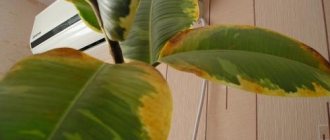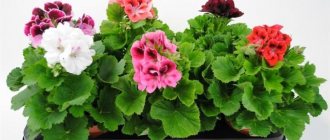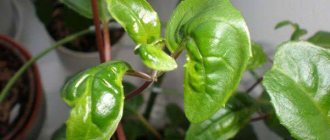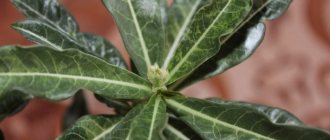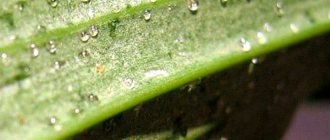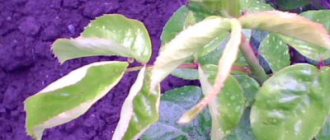Ficus pleases the eye until various troubles begin to happen to it. It often happens that the plant begins to wither, turn pale, and the leaf blades fall off. In order to understand why ficus leaves curl, you first need to remember whether there have been any changes in the care of the flower recently. If this happened, then by eliminating these nuances, it will be possible to restore a decent appearance to the plant.
Today there are a number of pests that attack indoor flowers. And although ficus is considered a fairly strong plant, sometimes the cause of the problem lies precisely in this.
How pests affect ficus
Having corrected all the errors in care that occurred, we can assume that the leaf plates are wrapped because pests have infested the flower.
The most common of them are:
- mealybug;
- spider mite;
- thrips;
- aphid;
- scale insects;
- nematodes.
By examining them separately, it will be possible to determine for sure why the leaves began to curl.
Infographics: reasons for curling ficus leaves and options for eliminating the problem
Mealybug
It is almost impossible not to notice the mealybug, because it is revealed by a white coating on the leaf blades, reminiscent of cotton wool. A beetle “lives” inside the lumps and sucks out all the juices from the leaves. It is not surprising that they begin to curl up and wither.
To eliminate the problem, you need to rinse the plant under warm water. After this, you will need to treat the ficus with a soap solution. If after treatment the situation has not changed, then you should buy chemical compounds and treat with these drugs. These include Actellik or Confidor. How to carry out the manipulation is indicated in the instructions.
Spider mite
Spider mites are no less dangerous to plants than mealybugs. Small red spiders can weave webs around both the stem and leaf blades. The difficulty is that due to its small size, it is not always possible to notice the tick. Over time, the affected flower “shows” with its entire appearance that it is infested with pests.
The leaf blades curl up, then turn yellow and fall off. To correct the problem, rinse the plant with water and then spray it with garlic solution. This should help, since the tick does not tolerate moisture. Actually, it starts in dry and hot rooms. And this is one of the nuances of improper care. If the plant is severely affected, do not wait. You need to purchase one of the insecticides in the store and treat the ficus with it.
Thrips
Thrips are no less dangerous. With their appearance, the leaves will not always curl. Sometimes dark veins or spots appear on the plates, then the leaves turn yellow and then begin to fall off. You can eliminate the problem, and to do this you need to treat the flower with Tanrek or Actellik.
Aphid
For those who don’t know, it’s worth saying that an aphid is a small green or light yellow bug that reproduces very quickly. Sometimes aphids “come” into the house along with new plants that have not been quarantined. In this case, you shouldn’t be surprised where the parasite came from, since the gardener himself “brought” it into the house.
This pest is dangerous because it sucks the juices from the flower, stopping its growth. In addition, aphids are carriers of viral diseases, so there will be nothing strange in the fact that after the pest is detected, the flower becomes sick. To eliminate the problem, the flower is thoroughly washed and all damaged shoots are removed. It would be a good idea to spray the ficus with pyrethrum.
Shields
If you wonder why ficus leaves curl inward and what to do, you may suspect that the plant has been attacked by a scale insect. Brown small bugs often “settle” on the inside of the leaf, so it is not always possible to notice them in time.
Parasites suck the juice out of the plant, which affects the appearance of the flower. Not only is the scale insect harmful in itself, it also produces “honeydew”, which leads to the development of sooty fungus. In order to save the ficus, it is recommended to remove all pests from the flower, and for prevention, also treat the bush with a soap solution.
Nematodes
Nematodes can usually be identified by the flaccidity of the flower. The particular difficulty of this problem is that pests attack the root system. That is, they “settle” right on the roots. The secretions of these parasites are particularly toxic, and this, again, affects the appearance of the plant. The leaves of the ficus wither or curl, and the flower gradually dies. In order to recognize pests, you should remove the ficus from the pot and carefully examine the root system. You will notice small “beads” on it, which are nematodes. Insecticides are used to save the flower.
Important! Having noticed pests, it is necessary to immediately begin to combat them, otherwise it may be too late.
You need to understand that the parasite can easily spread to neighboring flowers.
What can I do to stop the plant from curling inward and cracking?
To help a flower, it is necessary to provide it with comfortable conditions and proper care. To do this you need to follow certain requirements:
- periodically feed with mineral fertilizers;
- protect ficus from drafts;
- replant in a timely manner, using only high-quality and purified soil;
- monitor the appearance of parasites and, if necessary, get rid of them immediately;
- avoid excess or lack of moisture;
- Avoid contact with direct sunlight.
You can restore foliage by identifying the cause of its deformation. If this is due to pests, then the plant needs to be sprayed with a soap solution. If diseases develop, you will have to remove the affected areas and use chemicals. Then the leaves will stop curling, and the plant will acquire a well-groomed appearance.
5/5 — (1 vote)
Curling of the leaf plates of a ficus as a consequence of a flower disease
There are several diseases that can cause ficus leaves to curl inward. Depending on the extent of the problem, this may not be the case, but it is worth mentioning the diseases.
Some of the most common are:
- sooty fungus;
- cercospora;
- anthracnose;
- botrytis.
Sooty mushroom
Why sooty fungus appears was mentioned above. Its harbinger is often another pest. Another thing is that you need to know how to deal with it.
Considering that the disease can be recognized by the sticky coating on the leaves, it must be carefully removed with soap. To do this, you will need to soap the sponge well, and then wipe each leaf. If this is not done, the plant will begin to wither.
Cercospora
Cercospora blight is a fungal disease. Often the gardener himself is to blame for its occurrence, since it develops at high air humidity. The disease is indicated by black dots on the leaves. The solution to the problem is simple: you need to reduce watering of the ficus, remove the affected areas, and then spray the plant with an antifungal agent.
Anthracnose
Rusty spots on leaf plates are the main indicator of a problem. Of course, over time, the leaves may curl and fall off, but it is better not to let this happen. The problem must be solved by treating the flower with a Fungicide.
Botrytis
This disease is somewhat similar to the previous one, only in this case yellow-brownish spots with a dark edge appear on the leaves. Antifungal drugs can correct the situation.
Important! If there are doubts about a disease or pest that has infected the plant, then for prevention it would not be a bad idea to treat the ficus with an antifungal agent or insecticides.
Prevention measures
To prevent situations where leaves rotate inward, it is necessary to implement preventive measures, which include:
- spraying the ficus bush with water not only in summer, but also in winter;
- filling the tray in which there is a pot with a plant, expanded clay or wet pebbles to increase the humidity of the surrounding air;
- annual replanting of a young bush into a wider pot, and an adult plant - every 3 years;
- systematic inspection of foliage cover on ficus in order to identify pests and traces of disease on it;
- prohibition on pruning and replanting plants in winter or early spring;
- removing curled leaves only with obvious traces of disease or the presence of pests, since all other foliage, when growing conditions are normalized, is able to restore its previous condition.
Scrupulous adherence to the not-so-complicated agrotechnical rules for growing ficus trees, as well as a systematic inspection of the state of the plant’s green mass, guarantees that nothing will happen to its elegant leaves.
Other ficus problems
Sometimes the leaf curls with other problems that should be mentioned.
This:
- Sunburn. Once the flower stands at least a little under the scorching sun, the results are obvious. It is good if the sheet plates only curl and do not burn.
- Low temperature. If the room is very cold or the flower is in a draft, then it is not surprising that the leaves will begin to curl. It is very important to pay attention to the problem in time before the root system freezes.
- Lack of fertilizers. Sometimes, if there is a lack of nitrogen fertilizers, the shape of the leaf may change due to its curling inward. Feeding the ficus will eliminate this problem.
Foliage curling is not uncommon. The most important thing is to identify the factor that led to such consequences.
Possible causes of leaf deformation
Leaves curl for two main reasons - due to mechanical damage caused by insects, and due to violation of maintenance conditions: lighting level, temperature, lack of nutritional components obtained from the soil.
Development of the disease
Most ficus plants have strong immunity to the development of the disease. However, for a number of reasons, diseases can occur in any variety:
- lack of light;
- rare watering;
- soil waterlogging;
- low or excessively high air temperature;
- constant exposure to direct sunlight.
Diseases are the main cause of curling and discoloration of plant foliage:
- Powdery mildew . In the first stages of infection, it appears as spots, the surface of which is covered with fluff. Only in the initial phases of the development of the disease can it be combated; as it progresses, the leaf blade becomes thinner, twists inward, and falls off over time. The fungal disease is difficult to treat with fungicides; all affected tissue must be removed.
- Anthracnose . A rust-like stain forms on the top of the leaf blade (along the edges). In this place, the tissue becomes thinner, discolored, and holes appear. Diseased leaves fall off. Anthracnose belongs to a group of fungal diseases and is eliminated by fungicides containing copper.
- Gray rot . The disease is caused by mold. It is dangerous because the spores are on the surface and move freely through the air, spreading to other indoor flowers. The leaves are affected in several stages - first, brown spots appear, then the plate completely darkens, the edges become deformed and curled, and the foliage falls off. The reason for the development is increased humidity in the room, lack of fresh air, which contributes to the rapid spread of fungal spores.
- Cercospora blight . Develops due to excess moisture in the air. The fungus of the genus Cercospora manifests itself as small black or white dots on the underside of the leaf blade, which grow over time. The foliage turns yellow, curls up, and falls off.
- Sooty mushroom . It feeds on insect secretions, so it often appears after pest attacks. A powdery black coating appears on the leaves, the plate becomes deformed, the edges soften and curl inward.
When root rot develops, the leaves are the last to be affected. The disease develops from the roots, gradually spreads to the trunk, petioles, and only then leads to softening and curling of the foliage. At this stage, the plant can no longer be cured.
What size do you need: large or small?
The most important reasons why spathiphyllum leaves turn black. what to do to save the flower?
After purchasing a flower, you need to evaluate whether the container in which it is located can be considered suitable. There must be some free space in the pot. To prevent the root system from being crowded, the ficus needs to be transplanted into a new pot 3-4 weeks after purchase.
When choosing the size of the flowerpot, you need to pay attention to the following points:
- Keep in mind the “two centimeters” rule. That is, leave 2 cm of free space for the development of the root system. The new pot should be exactly that much larger than the previous one.
- If a small plant is placed in a container that is too large, all efforts will be spent on strengthening the root system. First, the roots will grow to the size of the pot, and only then will the above-ground part of the tree begin to grow. This also increases the risk of root rotting as a result of waterlogging.
- If there is not enough space for the roots, they will grow through the drainage holes. And if the tree’s crown further increases, the container may tip over under the weight of the tree. Therefore, a pot that is too small is also not suitable.
What color is best for the plant?
When choosing the color scheme of a pot, you need to pay attention to the following features:
- white or beige will fit into any stylistic direction of the interior;
- pastel colors are more suitable for the bedroom;
- bright colors look good in the kitchen or living room;
- green color will have a calming effect and relieve stress.
The color of the flowerpot does not have any effect on the development of the flower itself. The exception is containers of dark colors. If the plant is located on the south side, then a black or bright blue pot will attract even more light. Then the tree may suffer from its excess - get sunburn.
In what form should it grow?
Some experts believe that the shape of the flowerpot should be harmoniously combined with the outlines of the tree itself. Then the flower will easily fit into any interior.
And according to their appearance, ficus trees are conventionally divided into several groups:
- Male trees. They are distinguished by a powerful trunk, strong and mature bark. They often have corner branches. Such plants look better in a square or rectangular pot, where the corners are clearly defined.
- Women's. They look more sophisticated. They have a bark that is smooth to the touch, and the shoots always have a smooth bending line. For such specimens, oval or rounded pots are more suitable.
- Mixed type. It has characteristics of both male and female plants. It is considered universal - looks good in any container.
This classification is focused purely on the owner’s opinion and how he sees his ficus. In fact, the plant will do well in any pot except a round one.
Which potty do you like?
When growing ficus plants in the traditional way, you should pay more attention to the size of the container and its shape. And if you form a bonsai from a plant, then completely different requirements will be placed on the flowerpot:
- It is necessary to take into account the appearance of the tree and the specifics of its growth.
- A flat shape, close to a tray or plate, is preferable.
- The height of the sides should be no more than 10 cm. This is quite enough for the normal development of the root system.
- The width of the container will depend on the size of the crown. As the leaves grow, the width of the pot should increase.
- The underground part of the roots occupies a smaller area than the aboveground part. Therefore, it is advisable to use flowerpots made of breathable materials. These include wood and unglazed clay.
Ficus feels most comfortable in a clay pot. And from an aesthetic point of view, this option is more attractive.
